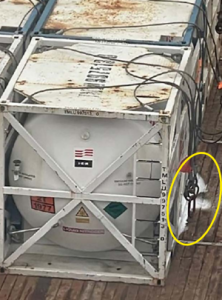As UK MAIB reports in its most recent Safety Digest, a supply vessel was in port and loading six containers of cargo in preparation for its next trip out to an offshore rig.
The incident
Each container held about 7500 litres of liquid nitrogen. The ship’s crew suspended cargo operations for the night and were awoken early the next morning by a loud bang. The crew mustered on the bridge and saw that ice was forming on the deck beneath one of the nitrogen tanks, indicating a leak from the container.
The crew recognised that they were faced with a hazardous situation and stopped anyone going near the leaking nitrogen or into the spaces in the decks below it. A specialist was called in to conduct tests of the atmosphere to make sure it was safe. The cargo deck was constructed from low carbon steel and, although suitable for shipbuilding, was not designed to withstand the very low temperature of -196°C that the evaporating nitrogen generated. Steel becomes brittle as its temperature drops and when the deck cargo was removed the crew found that a 4m² area of deck plating and the supporting steelwork had cracked due to their exposure to the low temperature.
A post-incident inspection found that both the main outlet valve and the bleed valve on the nitrogen container, which was not locked, were slightly open and had allowed the nitrogen to leak out through the open bleed valve.

Lessons learned
- Risk: The carriage of cryogenic gases requires careful consideration of the risks they pose to materials. In this case the simplest hazard control, which was that of keeping the nitrogen in the tank designed to contain it, failed because the valves were unsecured and vulnerable to being knocked open.
- Action: Once the crew had spotted the leak they made the right decision not to go dashing into areas where the atmosphere could be unsafe. Instead, they properly considered the risks before taking action.
- Monitor: It is likely that the main outlet valve was knocked open when the nitrogen was loaded, and a long time passed before the leak was noticed. An inspection of the cargo once it was on board and an effective deck watch overnight could have identified the leak much sooner and prevented damage to the ship.






























































